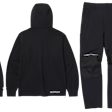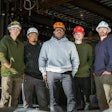
Heated jackets are one apparel option for construction workers to ensure comfort despite outdoor temperatures, enabling them to work more efficiently.
Heated jackets are typically made of carbon fiber, steel plates, or Graphene – a single layer of carbon atoms in a hexagonal lattice for efficiency and durability. Many have an outer layer of polyester, which warms up quickly and adapts to body heat.
However, to ensure safety, there are several factors to keep in mind.
Electrical Safety
One prime concern is electrical safety. Heated jackets are typically battery-powered and feature a pocket dedicated to a battery holder for a lithium-ion battery connecting to a cable entering the jacket lining. The heating element is activated through a power button and cycles through the heat settings, indicated by lights on the battery holder or on the outside of the jacket.
Because heated jackets are powered by electricity, it is crucial to ensure they are designed, constructed, tested, and certified to meet electrical safety standards. Assess worksite hazards that could damage the jacket or create electrical risks.
Most heated jackets use batteries of less than 10V, eliminating electrocution risk. The batteries are less than 12V DC with a frequency of 0Hz, which addresses high-frequency EMF radiation concerns.
While heated jackets typically derive their heat from power banks or batteries integrated into the lining, other options include chemically-heated jackets warmed with single-use packs or heating chemicals or stored-heat apparel that hold gel packs which are microwaved before use. A suitable power source ensures a construction worker wearing a heated jacket can use it to its full potential. Because they are battery-powered, heated jackets require access to electricity as they won’t provide the same level of warmth until they are charged again, although extra batteries or fully-charged power banks can provide back-up.
Since heated jackets come with rechargeable batteries or require connection to a power source, ensure the power source is compatible and suitable for the work environment. Batteries should be charged and maintained according to the manufacturer’s instructions.
Temperature control is provided in heated jackets. They are typically designed with heating elements strategically placed near the back, chest and arms with multiple heat settings enabling the worker wearing it to adjust the temperature to the desired comfort level in each zone. Ensure the temperature setting is as such that there will not be overheating, burns or other discomfort. The length of the time the jacket stays heated depends on the voltage of the battery.
Maximizing Usage
Layering is another approach to ensuring safety and comfort. A heated jacket is often worn as standalone outerwear or over other clothing layers. Extremely cold conditions may necessitate layering with other clothing to retain warmth. Wearing the jacket over other layers of clothing will enable a construction worker to remove it according to comfort needs, including the fact that the sleeves may limit mobility in work tasks.
Weatherproofing is an important factor when wearing heated jackets as construction work can expose workers to various weather conditions. Ensure the heated jacket is designed to be weather-resistant or waterproof to prevent electrical issues and maintain comfort. Waterproof membranes protecting the wires helps ensure the panels on heated jackets will not catch on fire or absorb moisture. While heated jackets may be waterproof, most are not intended to be worn in the rain or in wet conditions.
Safety gear compatibility is important. Ensure a heated jacket can be worn in conjunction with other personal protective equipment (PPE) such as harnesses and hard hats. Also, even though they are considered safe, those with pre-existing health conditions should check with a physician before wearing a heated jacket.
To maintain the integrity of the heated jacket, regularly inspect the jacket and its power source for signs of frayed wires, damage, or wear – if that’s an issue, do not use the jacket until it is repaired or replaced.
Read instruction manuals to understand safety precautions when wearing heated jackets. Some heated jackets can be machine-washed; others should be hand-washed. Safe storage when not in use helps ensure the jacket’s functionality and longevity.
Jobsite safety managers can assess whether a heated jacket can safely be worn on a construction site and train workers how to properly wear and maintain them.















